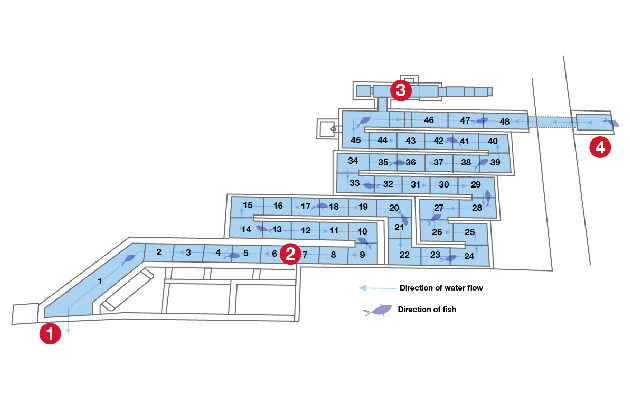Thompson Falls Fish Ladder
When dam construction began, the migratory nature of native fish species was not fully appreciated. Almost 100 years later through a series of studies, it was determined that construction of a fish ladder would be beneficial to connect more than 274 miles of upstream Clark Fork River Habitat. Fish ladders are commonly constructed on dams that block the passage of Pacific salmon and other anadromous species – those that migrate from the sea to spawn in rivers. However, Thompson Falls is upstream of the range of anadromous fish. The Clark Fork River at Thompson Falls is home to native Bull Trout, a federally listed threatened species, and Westslope Cutthroat Trout, as well as other sport and native fish. Fish managers concluded that connecting migratory habitat by constructing a fish passage facility for Bull Trout would help lead to the recovery of the native species.
Bull Trout are present in the lower Clark Fork River system in numbers so small it is very difficult to study them. A few attempts have been made to gather information on the swimming performance of Bull Trout in a laboratory setting, but with limited success. No one had ever built a fish ladder specifically for Bull Trout, and no one really knew how to design a fish way to attract and pass this species. Through collaborative work with partners, the construction of Montana’s first full-height fish ladder for Bull Trout was completed in late 2010.
Thompson Falls Fish Ladder: How We Track Fish

Fish Ladder Design

Fish Ladder Design
- Designing and positioning a fish ladder so fish can find and use it is a challenge - it’s not like you can put up a sign pointing the way. Migrating fish are attracted by a current and can be coaxed into certain areas by manipulating water flow. To lure fish to the ladder, flow up to 80 cubic feet per second (cfs) is discharged in front of its entrance pool.
- Once inside the ladder, fish swim from pool to pool against a 6 cfs flow. Pools are about 5 feet wide and 6 to 10 feet long. The total length of the ladder is 356 feet. The ladder was designed to assist fish migrating upriver. Fish traveling downstream pass over the dam or through the powerhouse.
- Near the top of the ladder is an area that can be used to trap and hold fish. Every morning, biologists check the holding area and count, sort, tag and measure all fish.
- Fish are released into the reservoir upstream of the dam. Most fish using the ladder are traveling to their natal spawning areas. Typically, bull trout, northern pikeminnow, peamouth and suckers pass through the ladder in the spring. Brown trout and mountain whitefish mostly use the ladder during the later summer and the fall.
In partnership with Montana Fish, Wildlife and Parks, U.S. Fish and Wildlife Service, and Confederated Salish and Kootenai Tribes, NorthWestern Energy operates the fish ladder, allowing native fish, especially threatened bull trout and several other salmonid and non-salmonid species, to migrate above the dam. Once fish ascend the ladder, biologists collect and track important information including population health. Engineers and biologists worked together to design the ladder to be effective at catching and passing fish in a complex environment at multiple flow levels.
Providing fish passage allows access to important upstream habitats including areas used for reproduction. Access to these spawning and rearing areas help to maintain genetic diversity to support the health of fish populations.
Fish Numbers
The fish ladder operates annually between March and October. Since operations began in 2011, more than 33,000 fish have been successfully gathered and passed upstream. Here you can review our historical data and observe the ongoing numbers of this year’s fish ladder season.


